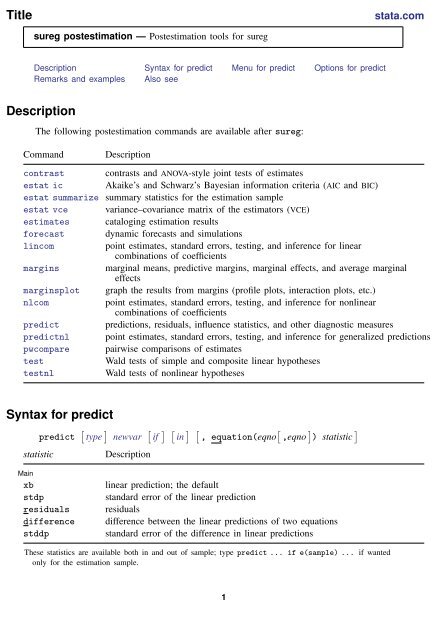sureg postestimation - Stata
sureg postestimation - Stata
sureg postestimation - Stata
You also want an ePaper? Increase the reach of your titles
YUMPU automatically turns print PDFs into web optimized ePapers that Google loves.
Title<br />
stata.com<br />
<strong>sureg</strong> <strong>postestimation</strong> — Postestimation tools for <strong>sureg</strong><br />
Description Syntax for predict Menu for predict Options for predict<br />
Remarks and examples Also see<br />
Description<br />
The following <strong>postestimation</strong> commands are available after <strong>sureg</strong>:<br />
Command Description<br />
contrast contrasts and ANOVA-style joint tests of estimates<br />
estat ic Akaike’s and Schwarz’s Bayesian information criteria (AIC and BIC)<br />
estat summarize summary statistics for the estimation sample<br />
estat vce variance–covariance matrix of the estimators (VCE)<br />
estimates cataloging estimation results<br />
forecast dynamic forecasts and simulations<br />
lincom<br />
point estimates, standard errors, testing, and inference for linear<br />
combinations of coefficients<br />
margins marginal means, predictive margins, marginal effects, and average marginal<br />
effects<br />
marginsplot graph the results from margins (profile plots, interaction plots, etc.)<br />
nlcom<br />
point estimates, standard errors, testing, and inference for nonlinear<br />
combinations of coefficients<br />
predict predictions, residuals, influence statistics, and other diagnostic measures<br />
predictnl point estimates, standard errors, testing, and inference for generalized predictions<br />
pwcompare pairwise comparisons of estimates<br />
test<br />
Wald tests of simple and composite linear hypotheses<br />
testnl<br />
Wald tests of nonlinear hypotheses<br />
Syntax for predict<br />
predict [ type ] newvar [ if ] [ in ] [ , equation(eqno [ ,eqno ] ) statistic ]<br />
statistic<br />
Description<br />
Main<br />
xb<br />
stdp<br />
residuals<br />
difference<br />
stddp<br />
linear prediction; the default<br />
standard error of the linear prediction<br />
residuals<br />
difference between the linear predictions of two equations<br />
standard error of the difference in linear predictions<br />
These statistics are available both in and out of sample; type predict . . . if e(sample) . . . if wanted<br />
only for the estimation sample.<br />
1
2 <strong>sureg</strong> <strong>postestimation</strong> — Postestimation tools for <strong>sureg</strong><br />
Menu for predict<br />
Statistics > Postestimation > Predictions, residuals, etc.<br />
Options for predict<br />
✄ <br />
✄ Main<br />
equation(eqno [ ,eqno ] ) specifies to which equation(s) you are referring.<br />
equation() is filled in with one eqno for the xb, stdp, and residuals options. equation(#1)<br />
would mean that the calculation is to be made for the first equation, equation(#2) would mean<br />
the second, and so on. You could also refer to the equations by their names. equation(income)<br />
would refer to the equation named income and equation(hours) to the equation named hours.<br />
If you do not specify equation(), the results are the same as if you specified equation(#1).<br />
difference and stddp refer to between-equation concepts. To use these options, you must<br />
specify two equations, for example, equation(#1,#2) or equation(income,hours). When<br />
two equations must be specified, equation() is required.<br />
xb, the default, calculates the linear prediction (fitted values)—the prediction of x j b for the specified<br />
equation.<br />
stdp calculates the standard error of the prediction for the specified equation. It can be thought of as<br />
the standard error of the predicted expected value or mean for the observation’s covariate pattern.<br />
The standard error of the prediction is also referred to as the standard error of the fitted value.<br />
residuals calculates the residuals.<br />
difference calculates the difference between the linear predictions of two equations in the system.<br />
With equation(#1,#2), difference computes the prediction of equation(#1) minus the<br />
prediction of equation(#2).<br />
stddp is allowed only after you have previously fit a multiple-equation model. The standard error of<br />
the difference in linear predictions (x 1j b − x 2j b) between equations 1 and 2 is calculated.<br />
For more information on using predict after multiple-equation estimation commands, see [R] predict.<br />
<br />
Remarks and examples<br />
stata.com<br />
For an example of cross-equation testing of parameters using the test command, see example 1<br />
in [R] <strong>sureg</strong>.<br />
Example 1<br />
In example 1 of [R] <strong>sureg</strong>, we fit a seemingly unrelated regressions model of price and weight.<br />
Here we obtain the fitted values.<br />
. use http://www.stata-press.com/data/r13/auto<br />
(1978 Automobile Data)<br />
. <strong>sureg</strong> (price foreign length) (weight foreign length), small dfk<br />
(output omitted )<br />
. predict phat, equation(price)<br />
(option xb assumed; fitted values)<br />
. predict what, equation(weight)<br />
(option xb assumed; fitted values)
<strong>sureg</strong> <strong>postestimation</strong> — Postestimation tools for <strong>sureg</strong> 3<br />
. summarize price phat weight what<br />
Variable Obs Mean Std. Dev. Min Max<br />
price 74 6165.257 2949.496 3291 15906<br />
phat 74 6165.257 1656.407 1639.872 9398.138<br />
weight 74 3019.459 777.1936 1760 4840<br />
what 74 3019.459 736.9666 1481.199 4476.331<br />
Just as in single-equation OLS regression, in a SURE model the sample mean of the fitted values<br />
for an equation equals the sample mean of the dependent variable.<br />
Example 2<br />
Suppose that for whatever reason we were interested in the difference between the predicted values<br />
of price and weight. predict has an option to compute this difference in one step:<br />
. predict diff, equation(price, weight) difference<br />
diff is the same as phat - what:<br />
. generate mydiff = phat - what<br />
. summarize diff mydiff<br />
Variable Obs Mean Std. Dev. Min Max<br />
diff 74 3145.797 1233.26 -132.2275 5505.914<br />
mydiff 74 3145.797 1233.26 -132.2275 5505.914<br />
Also see<br />
[R] <strong>sureg</strong> — Zellner’s seemingly unrelated regression<br />
[U] 20 Estimation and <strong>postestimation</strong> commands

















